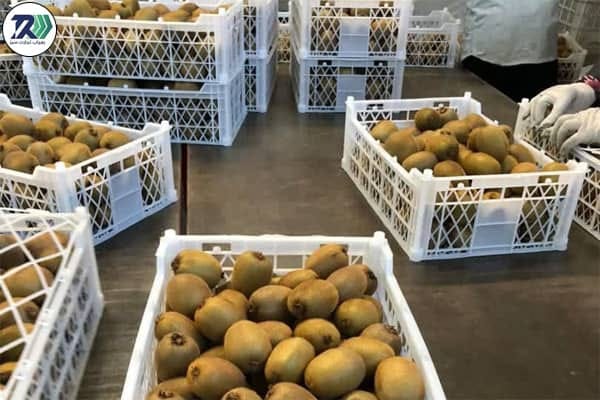Kiwi fruit is a delicious and nutritious fruit that originates from China, but is now grown and exported by many countries around the world. Kiwi fruit has many health benefits, such as boosting immunity, improving digestion, lowering blood pressure, and preventing kidney stones. Kiwi fruit is also rich in vitamin C, vitamin K, vitamin E, folate, potassium, fiber, and antioxidants. In this article, we will provide a comprehensive guide on how to produce, package and Export Kiwi to India
What is kiwi fruit?
Kiwi fruit is the edible berry of the woody vine Actinidia deliciosa, which belongs to the family Actinidiaceae. It has a brown, fuzzy skin, and a green, juicy pulp that contains tiny black seeds. Kiwi fruit has a sweet and tangy flavor, and a soft and creamy texture. Kiwi fruit comes in different varieties, such as green, gold, red, and baby kiwi.

How to produce kiwi fruit?
Kiwi fruit production is a complex and labor-intensive process that involves several stages, such as:
– *Site selection and preparation*: The kiwi vine should be planted in a well-drained, fertile, and pest-free soil, with adequate sunlight, water, and air circulation. The soil should be tested and amended if necessary, and the site should be cleared of weeds, rocks, and debris.
– *Planting and pruning*: The kiwi vine should be planted in rows, with enough space between them to allow for growth and maintenance. The vine should be trained and supported by a trellis system, such as T-bar, pergola, or espalier. The vine should be pruned regularly to remove dead, diseased, or damaged branches, and to shape and balance the canopy. Pruning can also improve fruit quality, yield, and pest resistance.
– *Fertilization and irrigation*: The kiwi vine should be fertilized with organic or synthetic fertilizers, depending on the soil condition and nutrient requirements. The fertilizers should be applied in the spring and summer, before and after flowering, and during fruit development. The kiwi vine should also be irrigated with drip or sprinkler systems, depending on the climate and water availability. The irrigation should be adjusted according to the soil moisture and weather conditions, and should be avoided during harvest time.
– *Pest and disease management*: The kiwi vine should be protected from pests and diseases, such as insects, mites, fungi, bacteria, viruses, and birds. The pest and disease management can be done by using cultural, biological, or chemical methods, or a combination of them. Some of the common pest and disease problems in kiwi fruit production are kiwi fruit vine canker, kiwi fruit vine decline, kiwi fruit psyllid, kiwi fruit bud mite, and kiwi fruit bacterial canker.
– *Harvesting and storage*: The kiwi fruit should be harvested when they are mature, but not ripe. The maturity can be determined by the color, size, shape, firmness, and sugar content of the fruits. The fruits should be picked by hand, with care and gentleness, to avoid bruising, damage, or infection. The fruits should be sorted, graded, and packed in boxes or crates, and stored in a cool, dry, and ventilated place. The storage temperature and humidity should be controlled to prevent decay, shrinkage, or loss of quality.

How to package kiwi fruit?
Packaging is an important step in the post-harvest handling of kiwi fruit, as it can extend the shelf life and maintain the quality of the fruits during distribution and transport. Packaging can also provide information, convenience, and appeal to the consumers. The packaging of kiwi fruit can be done by using different materials and techniques, such as:
– *Wooden boxes*: Wooden boxes are traditional and durable packaging materials that can hold a large amount of fruits. They can also provide good ventilation and insulation, and protect the fruits from mechanical damage. However, wooden boxes are heavy, bulky, and expensive, and can harbor pests and pathogens. They also require special treatment and disposal, and are not environmentally friendly.
– *Corrugated fiber boxes*: Corrugated fiber boxes are made of paperboard, which is lightweight, cheap, and recyclable. They can also provide good cushioning and shock absorption, and can be printed with labels and logos. However, corrugated fiber boxes are not very strong, and can be easily damaged by moisture, heat, or insects. They also have limited ventilation and insulation, and can affect the flavor and aroma of the fruits.
– *Plastic crates*: Plastic crates are made of polyethylene, polypropylene, or polystyrene, which are synthetic and non-biodegradable materials. They are strong, durable, and reusable, and can resist moisture, heat, and insects. They can also provide good ventilation and insulation, and can be stacked and handled easily. However, plastic crates are expensive, and can generate a lot of waste and pollution. They also have a negative impact on the environment and human health.
– *Modified atmosphere packaging (MAP)*: MAP is a technique that involves modifying the composition of the gas inside the packaging, by reducing the oxygen and increasing the carbon dioxide levels. This can slow down the respiration, ripening, and senescence of the fruits, and inhibit the growth of microorganisms. MAP can also preserve the color, texture, and flavor of the fruits, and extend the shelf life. However, MAP is complex, costly, and requires special equipment and materials. It can also cause anaerobic respiration, fermentation, or off-flavors in the fruits, if not done properly.
– *Active packaging*: Active packaging is a technique that involves adding substances or agents to the packaging, that can interact with the fruits or the environment, and improve the quality and safety of the fruits. Some examples of active packaging are:
– *Antimicrobial packaging*: Antimicrobial packaging contains substances that can kill or inhibit the growth of microorganisms, such as bacteria, fungi, or viruses, that can cause spoilage or infection in the fruits. Some examples of antimicrobial substances are silver, copper, zinc, or natural extracts, such as essential oils, spices, or herbs.
– *Antioxidant packaging*: Antioxidant packaging contains substances that can scavenge or neutralize the free radicals, that can cause oxidative damage or browning in the fruits. Some examples of antioxidant substances are vitamin

Annual Export of Hayward Kiwifruit from Iran to India
Iran is one of the main suppliers of kiwifruit in the world, and India is one of its main export destinations. According to the United States Department of Agriculture (USDA), Iran exported 19,700 tons of kiwifruit to India in 2020, valued at 16,300,000 USD[^1^][1]. This article will examine the reasons behind the high demand for Iranian kiwifruit in India, the challenges faced by Iranian kiwifruit exporters, and the prospects for future trade.
Why India Prefers Kiwifruit from Iran
India is the second-largest producer of kiwifruit in the world, after China, with an annual production of 2.35 million tons[^2^][2]. However, domestic production is not enough to meet the growing demand of the Indian consumers, who consume about 2.4 kg of kiwifruit per capita per year[^3^][3]. Therefore, India imports kiwifruit from various countries, such as New Zealand, Italy, Belgium, and Chile. Among these, Iran has emerged as a preferred source of kiwifruit for India, especially in the southern markets.
There are several factors that make Iranian kiwifruit attractive for Indian buyers. First, Iranian kiwifruit have a shorter transit time compared to other origins, as they can reach India by sea in about 10 days. This reduces the transportation costs and the risk of spoilage. Second, Iranian kiwifruit have a competitive price compared to other origins, as they are exempted from import duties under the preferential trade agreement between Iran and India. According to the USDA, the average price per ton of Iranian kiwifruit in 2020 was 503 USD, while the average price of New Zealand kiwifruit was 1,158 USD[^1^][1]. Third, Iranian kiwifruit have a good quality and taste, as they are grown in favorable climatic conditions and are harvested at the right time. Iranian kiwifruit are also diverse in terms of varieties, sizes, and colors, which cater to the preferences of different segments of the Indian market.

Challenges Faced by Iranian Kiwifruit Exporters
Despite the advantages of Iranian kiwifruit, there are also some challenges that Iranian kiwifruit exporters face in the Indian market. One of the main challenges is the fluctuation of the exchange rate between the Iranian rial and the Indian rupee, which affects the profitability of the trade. The Iranian rial has been depreciating against the Indian rupee due to the US sanctions and the economic crisis in Iran, which makes it difficult for Iranian exporters to set a stable price for their products. Another challenge is the lack of adequate cold storage facilities and packaging standards in Iran, which affect the quality and shelf life of the kiwifruit during transportation and storage. Moreover, Iranian kiwifruit exporters have to compete with other origins, such as New Zealand, which has a larger market share and a better distribution network in India.
Prospects for Future Trade
Despite the challenges, the trade of kiwifruit between Iran and India has a lot of potential for growth in the future. According to the USDA, India’s kiwifruit imports are expected to increase slightly in the market year 2022-23, as the domestic production is likely to remain stagnant and the consumer demand is likely to recover from the impact of the Covid-19 pandemic[^2^][2]. Iranian kiwifruit are expected to continue their strong export growth in the latter half of the market year, as they can benefit from the seasonal gap in the domestic supply and the lower import prices. Furthermore, Iranian kiwifruit exporters can explore new opportunities to expand their market share and customer base in India, by improving their quality standards, branding, and marketing strategies, and by establishing long-term relationships with Indian importers and retailers.
Sustainable Economic Development Through Kiwi Exports to India: A Comprehensive Review
Abstract
Kiwi exports to India can play a significant role in the sustainable economic development of Iran. Considering the strong diplomatic relations between the two countries and the favorable geographical position, this article examines the opportunities and challenges facing Iranian exporters.
Introduction
Kiwi, as an agricultural product with high nutritional value and good shelf life, can be one of the main axes of Iran’s exports to India. This fruit, which has a high demand in global markets, can act as a strategic product in developing trade relations between the two countries.
Market Review of Kiwi in India
India, with the world’s second-largest population and continuous economic growth, is a potential market for kiwi exports. The increasing public awareness of the health benefits of kiwi and the desire for quality fruits create opportunities for Iranian exporters.
Advantages of Kiwi Exports to India
Increase in Foreign Currency Earnings
Kiwi exports to India can lead to an increase in foreign currency earnings and help strengthen the agricultural sector.
Strengthening Trade Relations
Kiwi exports can serve as a diplomatic tool and lead to the consolidation of Iran-India relations.
Diversification of the Export Market
Kiwi, as a new and different product, can contribute to diversifying and enhancing Iran’s competitive strength in global markets.
Export Optimization Strategies
To achieve success in kiwi exports, it is necessary to adopt systematic and targeted strategies that include market research, logistical planning, and digital marketing.
Conclusion
Iran and India have a long history of trade and cultural ties, and kiwifruit are one of the products that symbolize this relationship. Iranian kiwifruit have a high demand in the Indian market, due to their shorter transit time, competitive price, and good quality. However, Iranian kiwifruit exporters also face some challenges, such as the exchange rate fluctuation, the lack of cold storage facilities, and the competition from other origins. To overcome these challenges and to increase their trade potential, Iranian kiwifruit exporters need to adopt better practices and strategies to meet the expectations and needs of the Indian consumers.
Kiwi exports to India can emerge as a new path to international markets and elevate Iran’s position in global trade. With careful planning and utilization of available opportunities, this product can become one of the main pillars of the country’s exports.
We suggest you to visit the Export Apples to India page


